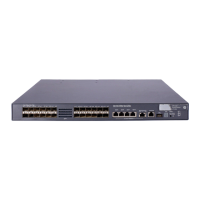19
To do… Use the command… Remarks
4. Configure the IP address of
the HTTP server as the
destination address of HTTP
request packets.
destination ip ip-address
Required.
By default, no destination IP
address is configured.
5. Configure the source IP
address of request packets.
source ip ip-address
Optional.
By default, no source IP address is
specified.
The source IP address must be the
IP address of a local interface.
The local interface must be up;
otherwise, no probe packets can
be sent out.
6. Configure the operation type.
operation { get | post }
Optional.
By default, the operation type for
the HTTP is get, which means
obtaining data from the HTTP
server.
7. Configure the website that an
HTTP test visits.
url url Required.
8. Configure the HTTP version
used in HTTP tests.
http-version v1.0
Optional.
By default, HTTP 1.0 is used.
9. Configure optional
parameters.
See “Configuring optional
parameters for an NQA test
group”
Optional.
NOTE:
The TCP port must be port 80 on the HTTP server for NQA HTTP tests.
Configuring UDP jitter tests
Do not perform NQA UDP jitter tests on known ports, ports from 1 to 1023. Otherwise, UDP jitter tests
might fail or the corresponding services of this port might be unavailable.
Real-time services such as voice and video have high requirements on delay jitters. UDP jitter tests of an
NQA test group obtain uni/bi-directional delay jitters. The test results help you verify whether a network
can carry real-time services.
A UDP jitter test takes the following procedure:
1. The source sends packets at regular intervals to the destination port.
2. The destination affixes a time stamp to each packet that it receives, and then sends it back to the
source.
3. Upon receiving the response, the source calculates the delay jitter, which reflects network
performance. Delay refers to the amount of time it takes a packet to be transmitted from source to
destination or from destination to source. Delay jitter is the delay variation over time.

